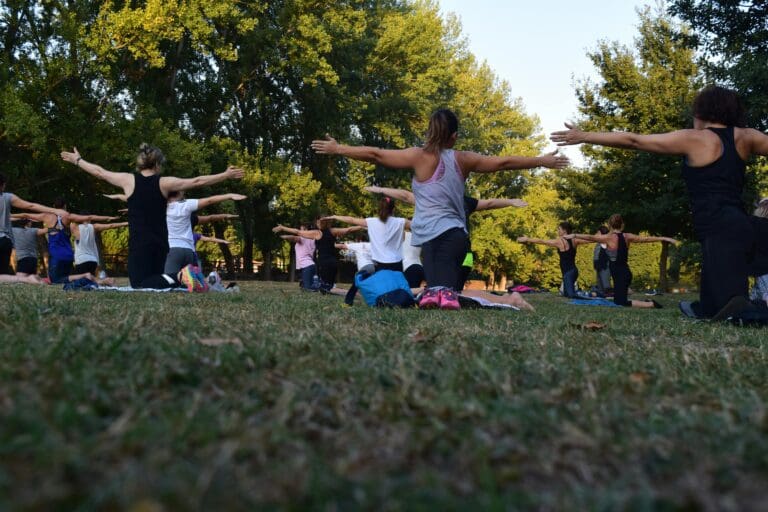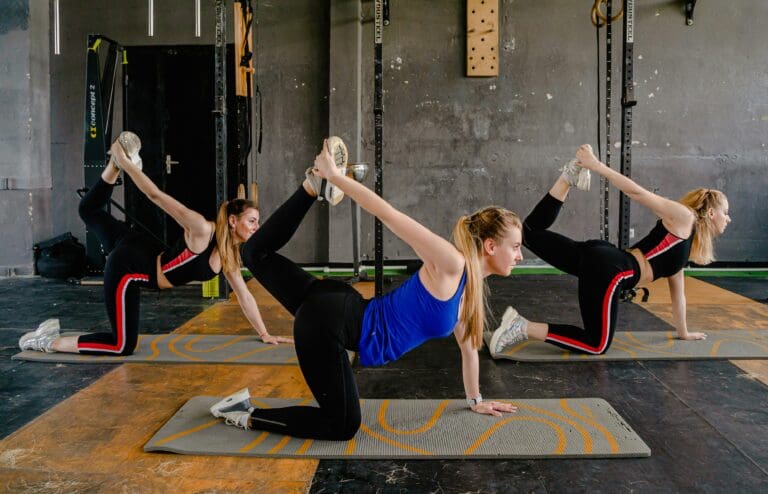Understanding Yoga Mat Thickness
The thickness of a yoga mat plays an important role in your comfort and how connected you feel to the ground during your practice. Generally, mats come in different thicknesses:
- ck.
- Standard yoga mat is around 1/8 inch thi
- Thicker mats are about 1/4 inch, offering extra cushioning.
- Thin or travel mats are 1/16 inch thick, making them lightweight and easy to carry.
When selecting a yoga mat, think about factors like how portable it is, how much comfort you need, and how stable you want to feel.
A thicker mat is ideal if you want extra padding for your knees and joints, making it great for slower or restorative yoga styles. However, it can be bulkier and harder to carry around.
On the other hand, thinner mats are lighter, easier to pack, and perfect for those who want to feel more grounded during their practice.
For a good balance of comfort and stability, natural rubber mats are a great choice. They offer enough cushioning without feeling too soft. It helps you stay steady during standing poses.
Importance of Thickness
- The thickness of a yoga mat is crucial for comfort and support during practice.
- An ideal yoga mat should provide the right amount of cushioning and grip.
- Thickness also affects the durability and lifespan of the mat.
Choosing the Right Yoga Mat Material
The material of a yoga mat affects its texture, stickiness, eco-friendliness, and sponginess. Options include PVC, recycled and natural rubber, jute, and organic cotton.
A PVC mat is durable and suitable for people with latex allergies, but it can contain harmful substances like phthalates and is difficult to recycle due to its toxic nature. Traditional sticky mats, mostly PVC mats, offer good durability and grip but are not eco-friendly.
A cotton yoga mat, for instance, offers a raised, tactile pattern for better grip, making it ideal for those seeking to avoid slipping during vigorous yoga sessions. Consider allergies, durability, and eco-friendliness when choosing a yoga mat.
Eco-friendly yoga mats are made from natural or recycled materials. Look for yoga mats made from sustainable materials and those that use recycled materials.
Eco-Friendly Options
Natural rubber mats are a good alternative to PVC mats, made from natural rubber harvested from the Pará rubber tree.
Cork yoga mats are a sustainable option made from natural cork.
Consider yoga mats made from organic cotton for a more eco-friendly option.
Look for yoga mats with a textured surface for better grip and stability.
PVC Yoga Mat: A Popular Option
PVC yoga mats are the most common type of yoga mat, but they contain phthalates and are not recyclable. Cheap yoga mats, particularly PVC mats, pose health and environmental risks due to harmful chemicals like phthalates and heavy metals.
PVC yoga mats have the highest sticky factor, which helps prevent slipping during yoga practice. The texture of a pvc yoga mat provides excellent grip, but maintaining cleanliness is crucial to preserve their stickiness. Consider alternative materials like natural rubber or TPE for a more eco-friendly option. Look for yoga mats made from PVC-free materials or those that use recycled PVC.
Yoga Mat Texture and Grip
The texture of a yoga mat affects its traction and comfort. Options include smooth, raised, and tactile patterns. Consider your personal preference for texture when choosing a yoga mat.
A sticky yoga mat helps maintain alignment and prevents slipping, offering a balance between performance and environmental responsibility.
Texture Options
Smooth texture is best for hot yoga and sweaty practices.
Raised texture provides extra grip and traction.
Tactile patterns offer a unique grip and comfort.
Style of Practice and Yoga Mat Choice
The style of yoga you practice determines your yoga mat needs, with different yoga mats suitable for different styles. Most yoga mats vary in quality, size, and texture, making them suitable for different types of workouts; it’s important to choose safer, eco-friendly options.
Consider the type of poses you’ll be doing and the level of cushioning and traction you need. Look for a yoga mat that suits your body type and practice style.
Basic Classes (Level 1)
If you’re new to yoga or prefer a calmer practice, look for a yoga mat with good traction, comfort, and stability.
Consider a less expensive yoga mat or renting a mat from the studio if you’re unsure about committing to a purchase.
Look for a yoga mat with a good amount of traction and some cushioning.
Flow/Vinyasa Styles
If you practice flow or vinyasa yoga, look for a mat with great traction, especially for poses like Downward Facing Dog.
Consider a yoga mat with a textured surface for better grip and stability.
Look for a mat that can handle your sweat and provides good traction even when wet.
Restorative or Yin Classes
If you practice restorative or yin yoga, look for a plush and comfortable yoga mats with extra cushioning.
Consider a mat with a large practice area and a textured surface for better grip.
Look for yoga mats that provide extra cushioning and support for your joints.
Portability vs Comfort & Stability
Consider the trade-off between portability and comfort and stability when choosing a yoga mat. Look for yoga mats that strike a balance between the two. Consider the weight and size of the mat when choosing a portable option.
Travel Yoga Mats
Travel yoga mats are designed to be lightweight and compact.
Look for yoga mats made from eco-friendly materials and those that use recycled materials.
Consider a thicker mat for extra cushioning and support.
Caring for Your Yoga Mat
Clean your yoga mats regularly with a damp cloth to prevent the buildup of sweat and oils. Consider deep cleaning your mat with mild soap and water, especially if you practice hot yoga.
Look for yoga mats with easy cleaning instructions and those that can be washed in a machine.
Cleaning and Maintenance
Avoid using alcohol, petroleum-based solvents, or high concentration essential oils on your yoga mat, as they can cause damage and dryness.
To disinfect your mat, mix equal parts distilled water and white vinegar, or use a non-toxic disinfectant like Force of Nature.
For cleaning dirt and grime, mix a few drops of dish soap with warm water, spray on the mat, and wipe off with a damp towel.
Top Picks for Yoga Mats
- The JadeYoga Harmony Mat offers great grip and durability and is perfect for those who need extra stability during yoga. This natural rubber mat is made from natural rubber collected from rubber trees, thus it’s eco-friendly.
The mat provides soft cushioning and excellent traction. It’s indeed ideal for various yoga styles.
- The Manduka eKO Mat 5mm is a top pick for comfort and support. Its soft yet grippy surface is made from non-toxic, biodegradable natural tree rubber.
Like other natural rubber mats, it offers a perfect mix of cushioning and stability. Its closed-cell design keeps sweat out and is great for hot yoga classes.
- The 42 Birds “The Robin” Cork Lightweight Yoga Mat has a smooth but grippy cork surface. It’s lightweight and easy to carry and is great for yogis on the go. The cork surface provides a natural non-slip grip that improves when it gets wet.
This is perfect for sweaty hands and feet. Plus, cork is a sustainable material, making this yoga mat an eco-friendly choice.
Conclusion
Choosing the right yoga mat can enhance your practice and provide comfort and support. Pay attention to factors like thickness, material, texture, and whether it’s eco-friendly. Natural rubber mats, in particular, are great because they provide excellent grip, cushioning, and are better for the environment. Look for yoga mats that offer a good mix of portability, comfort, and stability.




